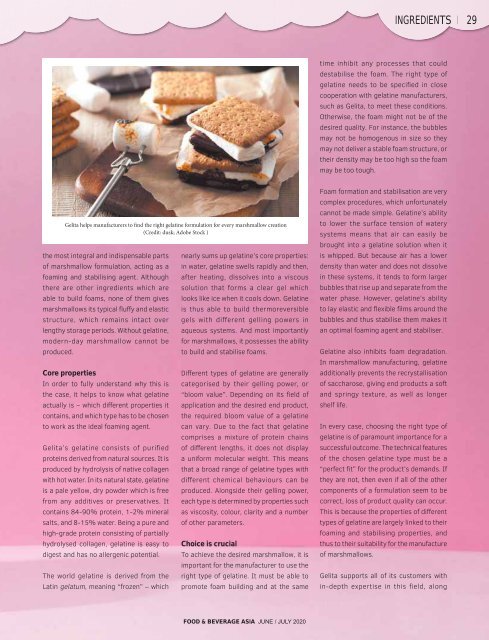Food & Beverage Asia June/July 2020
Food & Beverage Asia (FBA) is the leading source of food and beverage news in Asia since 2002. FBA delivers a comprehensive view of the food and beverage landscape, spanning across the latest health and nutrition trends and industry innovations in ingredients, recipe formulations, food science, sustainability, packaging, and automation, as well as advancements in agri and food-tech.
Food & Beverage Asia (FBA) is the leading source of food and beverage news in Asia since 2002. FBA delivers a comprehensive view of the food and beverage landscape, spanning across the latest health and nutrition trends and industry innovations in ingredients, recipe formulations, food science, sustainability, packaging, and automation, as well as advancements in agri and food-tech.
Create successful ePaper yourself
Turn your PDF publications into a flip-book with our unique Google optimized e-Paper software.
INGREDIENTS<br />
29<br />
time inhibit any processes that could<br />
destabilise the foam. The right type of<br />
gelatine needs to be specified in close<br />
cooperation with gelatine manufacturers,<br />
such as Gelita, to meet these conditions.<br />
Otherwise, the foam might not be of the<br />
desired quality. For instance, the bubbles<br />
may not be homogenous in size so they<br />
may not deliver a stable foam structure, or<br />
their density may be too high so the foam<br />
may be too tough.<br />
Gelita helps manufacturers to find the right gelatine formulation for every marshmallow creation<br />
(Credit: dusk; Adobe Stock )<br />
the most integral and indispensable parts<br />
of marshmallow formulation, acting as a<br />
foaming and stabilising agent. Although<br />
there are other ingredients which are<br />
able to build foams, none of them gives<br />
marshmallows its typical fluffy and elastic<br />
structure, which remains intact over<br />
lengthy storage periods. Without gelatine,<br />
modern-day marshmallow cannot be<br />
produced.<br />
Core properties<br />
In order to fully understand why this is<br />
the case, it helps to know what gelatine<br />
actually is – which different properties it<br />
contains, and which type has to be chosen<br />
to work as the ideal foaming agent.<br />
Gelita’s gelatine consists of purified<br />
proteins derived from natural sources. It is<br />
produced by hydrolysis of native collagen<br />
with hot water. In its natural state, gelatine<br />
is a pale yellow, dry powder which is free<br />
from any additives or preservatives. It<br />
contains 84-90% protein, 1-2% mineral<br />
salts, and 8-15% water. Being a pure and<br />
high-grade protein consisting of partially<br />
hydrolysed collagen, gelatine is easy to<br />
digest and has no allergenic potential.<br />
The world gelatine is derived from the<br />
Latin gelatum, meaning “frozen” – which<br />
nearly sums up gelatine’s core properties:<br />
in water, gelatine swells rapidly and then,<br />
after heating, dissolves into a viscous<br />
solution that forms a clear gel which<br />
looks like ice when it cools down. Gelatine<br />
is thus able to build thermoreversible<br />
gels with different gelling powers in<br />
aqueous systems. And most importantly<br />
for marshmallows, it possesses the ability<br />
to build and stabilise foams.<br />
Different types of gelatine are generally<br />
categorised by their gelling power, or<br />
“bloom value”. Depending on its field of<br />
application and the desired end product,<br />
the required bloom value of a gelatine<br />
can vary. Due to the fact that gelatine<br />
comprises a mixture of protein chains<br />
of different lengths, it does not display<br />
a uniform molecular weight. This means<br />
that a broad range of gelatine types with<br />
different chemical behaviours can be<br />
produced. Alongside their gelling power,<br />
each type is determined by properties such<br />
as viscosity, colour, clarity and a number<br />
of other parameters.<br />
Choice is crucial<br />
To achieve the desired marshmallow, it is<br />
important for the manufacturer to use the<br />
right type of gelatine. It must be able to<br />
promote foam building and at the same<br />
Foam formation and stabilisation are very<br />
complex procedures, which unfortunately<br />
cannot be made simple. Gelatine’s ability<br />
to lower the surface tension of watery<br />
systems means that air can easily be<br />
brought into a gelatine solution when it<br />
is whipped. But because air has a lower<br />
density than water and does not dissolve<br />
in these systems, it tends to form larger<br />
bubbles that rise up and separate from the<br />
water phase. However, gelatine’s ability<br />
to lay elastic and flexible films around the<br />
bubbles and thus stabilise them makes it<br />
an optimal foaming agent and stabiliser.<br />
Gelatine also inhibits foam degradation.<br />
In marshmallow manufacturing, gelatine<br />
additionally prevents the recrystallisation<br />
of saccharose, giving end products a soft<br />
and springy texture, as well as longer<br />
shelf life.<br />
In every case, choosing the right type of<br />
gelatine is of paramount importance for a<br />
successful outcome. The technical features<br />
of the chosen gelatine type must be a<br />
“perfect fit” for the product’s demands. If<br />
they are not, then even if all of the other<br />
components of a formulation seem to be<br />
correct, loss of product quality can occur.<br />
This is because the properties of different<br />
types of gelatine are largely linked to their<br />
foaming and stabilising properties, and<br />
thus to their suitability for the manufacture<br />
of marshmallows.<br />
Gelita supports all of its customers with<br />
in-depth expertise in this field, along<br />
FOOD & BEVERAGE ASIA JUNE / JULY <strong>2020</strong>


















